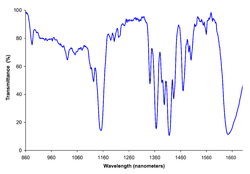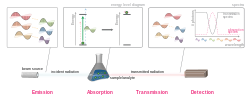Spectroscopy is the field of study that measures and interprets electromagnetic spectra. In narrower contexts, spectroscopy is the precise study of color...
44 KB (4,768 words) - 18:59, 23 May 2025
Infrared spectroscopy (IR spectroscopy or vibrational spectroscopy) is the measurement of the interaction of infrared radiation with matter by absorption...
53 KB (5,943 words) - 18:48, 22 May 2025
Raman spectroscopy (/ˈrɑːmən/) (named after physicist C. V. Raman) is a spectroscopic technique typically used to determine vibrational modes of molecules...
86 KB (10,080 words) - 13:15, 30 May 2025
Nuclear magnetic resonance spectroscopy, most commonly known as NMR spectroscopy or magnetic resonance spectroscopy (MRS), is a spectroscopic technique...
54 KB (6,192 words) - 06:59, 26 February 2025
Mössbauer spectroscopy is a spectroscopic technique based on the Mössbauer effect. This effect, discovered by Rudolf Mössbauer (sometimes written "Moessbauer"...
34 KB (3,710 words) - 10:39, 7 March 2025
spectrophotometry (UV–Vis or UV-VIS) refers to absorption spectroscopy or reflectance spectroscopy in part of the ultraviolet and the full, adjacent visible...
34 KB (4,440 words) - 01:30, 8 May 2025
Near-infrared spectroscopy (NIRS) is a spectroscopic method that uses the near-infrared region of the electromagnetic spectrum (from 780 nm to 2500 nm)...
31 KB (3,792 words) - 00:57, 26 February 2025
Hadron spectroscopy is the subfield of particle physics that studies the masses and decays of hadrons. Hadron spectroscopy is also an important part of...
2 KB (203 words) - 14:15, 9 December 2024
An infrared spectroscopy correlation table (or table of infrared absorption frequencies) is a list of absorption peaks and frequencies, typically reported...
7 KB (260 words) - 17:36, 18 May 2025
Microwave spectroscopy is the spectroscopy method that employs microwaves, i.e. electromagnetic radiation at GHz frequencies, for the study of matter....
8 KB (887 words) - 17:17, 16 May 2024
photoelectron spectroscopy (XPS), which also known as Electron Spectroscopy for Chemical Analysis (ESCA), Electron energy loss spectroscopy (EELS), Ultraviolet...
6 KB (782 words) - 13:00, 19 December 2024
Fourier transform infrared spectroscopy (FTIR) is a technique used to obtain an infrared spectrum of absorption or emission of a solid, liquid, or gas...
37 KB (4,802 words) - 21:24, 23 May 2025
Photothermal spectroscopy is a group of high sensitivity spectroscopy techniques used to measure optical absorption and thermal characteristics of a sample...
8 KB (1,120 words) - 11:44, 20 January 2024
Atomic emission spectroscopy (AES) is a method of chemical analysis that uses the intensity of light emitted from a flame, plasma, arc, or spark at a particular...
11 KB (1,375 words) - 09:40, 24 May 2025
Fluorescence spectroscopy (also known as fluorimetry or spectrofluorometry) is a type of electromagnetic spectroscopy that analyzes fluorescence from a...
22 KB (2,841 words) - 10:23, 24 May 2025
Astronomical spectroscopy is the study of astronomy using the techniques of spectroscopy to measure the spectrum of electromagnetic radiation, including...
47 KB (5,318 words) - 13:55, 23 February 2025
Absorption spectroscopy is spectroscopy that involves techniques that measure the absorption of electromagnetic radiation, as a function of frequency or...
22 KB (2,574 words) - 20:50, 18 March 2025
Fluorine-19 nuclear magnetic resonance spectroscopy (fluorine NMR or 19F NMR) is an analytical technique used to detect and identify fluorine-containing...
15 KB (1,222 words) - 13:43, 17 April 2025
Rotational spectroscopy is concerned with the measurement of the energies of transitions between quantized rotational states of molecules in the gas phase...
51 KB (7,154 words) - 07:00, 22 November 2024
Atomic absorption spectroscopy (AAS) is a spectro-analytical procedure for the quantitative measurement of chemical elements. AAS is based on the absorption...
31 KB (4,295 words) - 07:24, 13 April 2025
Gamma-ray spectroscopy is the qualitative study of the energy spectra of gamma-ray sources, such as in the nuclear industry, geochemical investigation...
27 KB (3,329 words) - 16:47, 14 January 2025
Force spectroscopy is a set of techniques for the study of the interactions and the binding forces between individual molecules. These methods can be used...
22 KB (2,787 words) - 20:48, 22 July 2024
Auger electron spectroscopy (AES; pronounced [oʒe] in French) is a common analytical technique used specifically in the study of surfaces and, more generally...
31 KB (4,117 words) - 04:12, 9 November 2024
Electron paramagnetic resonance (redirect from Electron spin resonance spectroscopy)
Electron paramagnetic resonance (EPR) or electron spin resonance (ESR) spectroscopy is a method for studying materials that have unpaired electrons. The...
52 KB (7,148 words) - 12:04, 25 May 2025
In physics and physical chemistry, time-resolved spectroscopy is the study of dynamic processes in materials or chemical compounds by means of spectroscopic...
15 KB (1,899 words) - 01:54, 25 May 2025
X-ray emission spectroscopy (XES) is a form of X-ray spectroscopy in which a core electron is excited by an incident X-ray photon and then this excited...
16 KB (2,128 words) - 23:58, 23 May 2025
Dielectric spectroscopy (which falls in a subcategory of the impedance spectroscopy) measures the dielectric properties of a medium as a function of frequency...
25 KB (3,097 words) - 14:24, 13 August 2024
Photoacoustic spectroscopy is the measurement of the effect of absorbed electromagnetic energy (particularly of light) on matter by means of acoustic detection...
11 KB (1,213 words) - 02:42, 30 May 2025
It can be applied to a variety of types of spectroscopy including optical spectroscopy, infrared spectroscopy (FTIR, FT-NIRS), nuclear magnetic resonance...
15 KB (1,889 words) - 05:20, 25 May 2025
Modern spectroscopy in the Western world started in the 17th century. New designs in optics, specifically prisms, enabled systematic observations of the...
51 KB (5,679 words) - 22:49, 22 May 2025





















